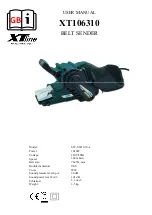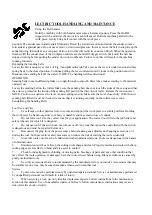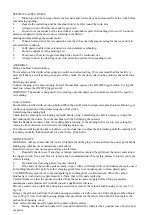
Caution! The sander may initially snatch forwards. Resist the forwards motion and allow the sander to move
forwards at a gradual pace. Do not use excessive, downward pressure, this may cause the belt to snap. Keep the
sander moving forwards at an even pace. Failure to do this will result in an uneven finish. When the operation
finished ,lift the sander clear of the workpiece and release the On/Off trigger switch. Wait until the belt has
stopped rotating before putting the sander down on workbench. Failure to do this will result in the machine
running forwards.
Replacing the Sanding belts
Locate the belt tension lever (see 1 of Fig.7)and pull outwards. Take care as the lever is under tension and may
spring back to the closed position. Continue pulling the lever outwards until it locks in the position shown in
Maneuver the sanding belt off the rollers. NOTE: The Sanding belt has directional
OPERATION
Sanding belts come in different grades i.e. rough through to smooth. Select the grade according to the material
operated on.
Locate the sanding belt on the rollers Make sure the sanding belt does not touch the sides of the casing and that
the arrows, printed on the inside of the sanding belt point in the direction of travel. Release the tension lever.
NOTE: Caution is required as the lever is under spring tension. Make sure the lever closes fully. With the new
sanding belt fitted it must be checked to ensure that it is running centrally on the rollers (see section
Centralizing the Sanding Belt).
Tool Use and Care
1.
Use clamps or other practical way to secure and support the work piece to a stable platform. Holding
the work piece by hand or against your body is unstable and may lead to loss of control.
2.
Do not force tool. Use the correct tool for your application. The correct tool will do the job better and
safer at the rate for which it is designed.
3.
Do not use tool if the switch can not turn on or off. Any tool that cannot be controlled with the switch
is dangerous and must be repaired before use.
4.
Disconnect the plug from the power source before making any adjustment, changing accessories, or
storing the tool. Such preventive safety measures can reduce the risk of starting the tool accidentally.
5.
Store idle tools out of reach of children and other untrained persons. Tools are dangerous in the hands
of untrained users.
6.
Maintain tools with care. Keep the cutting tools sharp and clean. Properly maintained tools with sharp
cutting edges are less likely to bind and are easier to control.
7.
Check for misalignment or binding of moving parts, breakage of parts and any other condition that
may affect the tools operation. If damaged, have the tool serviced before using. Many accidents are caused by
poorly maintained tools.
8.
Use only accessories that are recommended by the manufacturer for your model. Accessories that may
be suitable for one tool, may become hazardous when used on another tool.
Service
1.
Tool service must be performed only by qualified repair personnel. Service or maintenance performed
by unqualified personnel could result in a risk of injury.
2.
When servicing a tool, use only identical replacement parts. Follow instructions in the maintenance
section of this manual. Use of unauthorized parts or failure to follow maintenance instructions may create a
risk of electric shock or injury.
LECTRIC TOOL HANDLING AND MAINTANCE
Using the Belt Sander
Hold the machine with both hands and assume a balanced posture. Press the On/Off
trigger switch and allow the motor to reach full speed. Hold the machine parallel to the
work piece. Gently bring belt contact with the work piece.
Содержание XT106310
Страница 6: ...24 15 14 8 9...
Страница 7: ...stator lo isko...


































